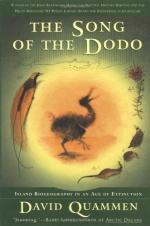
|
| Name: _________________________ | Period: ___________________ |
This test consists of 15 multiple choice questions and 5 short answer questions.
Multiple Choice Questions
1. What does Quammen say about each of the pieces?
(a) They are complex and well made.
(b) They are nothing without the whole.
(c) They are unintelligible without the whole design.
(d) They are each complete in themselves.
2. Where does Quammen say isolates can occur?
(a) On islands and on land.
(b) Only on islands.
(c) Only in areas separated by steep mountains or deserts.
(d) In the bottoms of lakes.
3. What were theories of species evolution based on in Wallace's time?
(a) Guesses.
(b) Religion.
(c) Superstition.
(d) Science.
4. What surprising dispersal ability does Quammen say elephants have?
(a) Ability to be carried in other animals' fur.
(b) Ability to swim long distances.
(c) Ability to go without water for weeks.
(d) Ability to be carried on wind currents.
5. Who is Owen Griffiths?
(a) A sailor from the 18th century.
(b) A monkey researcher in Mauritius.
(c) A bird researcher in Australia.
(d) An insect researcher in Madagascar.
6. What question does Quammen say was debated for years after Darwin's theories were published?
(a) Whether he acted honorably toward Wallace.
(b) Whether he developed the theory of evolution on his own.
(c) Whether he stole his work from Wallace.
(d) Whether he owed Wallace for the material he borrowed.
7. When does a species' dispersal ability become important, according to Quammen?
(a) When the species is isolated by mountain ranges or lakes.
(b) When an island loses all its life after a catastrophic event.
(c) When a species is forced to find new food sources.
(d) When a species is threatened by new predators.
8. Where did the dodo nest?
(a) On the ground.
(b) In burrows.
(c) In man-made structures.
(d) In trees.
9. What kinds of animals did Philip Darlington look at?
(a) Mammals.
(b) Birds.
(c) Reptiles.
(d) Insects.
10. What were Frank Preston's findings in plotting the distribution of species in island habitats?
(a) A direct proportion to represent commonness of species.
(b) A bell curve to represent commonness of species.
(c) An indirect proportion to represent commonness of species.
(d) A random relationship between size of island and commonness of species.
11. Where is Krakatau?
(a) Japan.
(b) Malay Archipelago.
(c) Italy.
(d) Tunisia.
12. What was Tasmania's environmental history, according to Quammen?
(a) It was formed by a volcano in the sea.
(b) It was isolated by a growing mountain range in India.
(c) It experienced a catastrophic eruption that killed off everything on the island, before life returned slowly.
(d) It was separated from Australia by water.
13. Who does Quammen say typically collected insects?
(a) Ambitious young Americans.
(b) The most devoted scientists.
(c) Hunters in the Amazon.
(d) Wealthy Brits.
14. What population does Quammen compare with the thylacine population?
(a) The indigenous people of Tasmania.
(b) The dodo.
(c) The Komodo dragon.
(d) The passenger pigeon.
15. What is the tone of Quammen's writing in the opening chapter?
(a) Bellicose.
(b) Familiar.
(c) Agitated.
(d) Morose.
Short Answer Questions
1. What assertion did Frank Preston make based on his data?
2. How many species of the animal Philip Darlington studied did an island of four square miles possess?
3. What literary term describes Quammen's use of the image of the Persian rug?
4. What is the term that encompasses David Quammen's overall idea?
5. How would you describe Quammen's narrative of the dodo's decline and extinction?
|
This section contains 579 words (approx. 2 pages at 300 words per page) |

|




